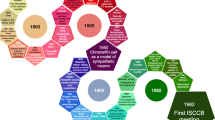Abstract
Some primitive autonomic ganglia transform into neurons, some into satellite and neurolemma cells associated with neurons, and others become distinct endocrine elements. The latter stain brown with chrome salts and are thus designated chromaffin cells. This reaction is the result of the presence of the hormone, epinephrine, contained within the cells. The chromaffin system consists of various aggregates of these cells throughout the body. The adrenal medulla is the most prominent member of the group.
Access this chapter
Tax calculation will be finalised at checkout
Purchases are for personal use only
Preview
Unable to display preview. Download preview PDF.
Similar content being viewed by others
Selected Readings
Burgoyne R D, Morgan A, Robinson I, Pender N, Cheek T R. Exocytosis in adrenal chromaffin cells. J Anat 1993; 183: 309.
Evans D B, Lee J E, Merrell R C, Hickey R C. Adrenal medullary disease in multiple endocrine neoplasia type 2. Appropriate management. Endocrin Metab Clin North Am 1994; 23: 167.
Graham P E, Smythe G A, Lazarus L. Laboratory diagnosis of pheochromocytoma: which analytes should we measure? Ann Clin Biochem 1993; 30: 129.
Hinson J P, Cameron L A, Purbrick A, Kapas S. The role of neuropeptides in the regulation of adrenal vascular tone: effects of vasoactive intestinal polypeptide, substance P, neuropeptide Y, neurotensin, Met-enkephalin, and Leu-enkephalin on perfusion medium flow rate in the intact perfused rat adrenal. Regul Pep 1994; 51: 55.
Nagatsu T. Genes for human catecholamine-synthesizing enzymes. Neurosci Res 1991; 12: 315.
Nativ O, Grant C S, Sheps S G, O’Fallon J R, Farrow G M, van Heerden J A, Lieber M M. The clinical significance of nuclear DNA pattern in 184 patients with pheochromocytoma. Cancer 1992; 69: 2683.
Raum WJ. Pheochromocytoma. In: Bardin C W, ed. Current Therapy in Endocrinology and Metabolism, 5th ed. St. Louis, MO: Mosby, 1994: 172.
Editor information
Editors and Affiliations
Rights and permissions
Copyright information
© 1997 Springer Science+Business Media New York
About this chapter
Cite this chapter
Raum, W.J. (1997). Adrenal Medulla (Catecholamine and Peptides). In: Conn, P.M., Melmed, S. (eds) Endocrinology. Humana Press, Totowa, NJ. https://doi.org/10.1007/978-1-59259-641-6_24
Download citation
DOI: https://doi.org/10.1007/978-1-59259-641-6_24
Publisher Name: Humana Press, Totowa, NJ
Print ISBN: 978-1-4757-5137-6
Online ISBN: 978-1-59259-641-6
eBook Packages: Springer Book Archive




